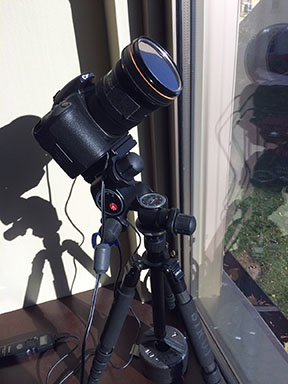Why is the image of the sun so small?
The analemma (the distorted figure-eight pattern) is more than 46 degrees long. The sun is actually only about 1/2 degree wide in the sky. It's the same size as the moon (hence eclipses), and easily covered by your index finger at arm's length. Better to test that statement with the moon! The sun seems bigger because it's so bright.
How did you return the camera to the exact same position each time?
The camera never moved. It was kept on a tripod on a windowsill in a hallway of Carole Sandner Hall for the whole year. I didn't even touch it. Wires connected it to a remote shutter control and power. A USB cable allowed downloading of the sun pictures to a computer. A lead weight was hung from the tripod for stability. The setup is shown below.

It was enclosed in a foam-board box. Thanks to Fr. Tim Scully, C.S.C. for permission to set it up!
How did you know what time to take the picture each day to get the analemma to encircle the dome?
I wrote a MATLAB program which calculates the position of the sun in the sky for any longitude and latitude on a specified dates and times. (The program is in the book as an example.) The coordinates of the window were determined using GPS and the elevation angles of the dome and surrounding buildings were measured with a sighting inclinometer. Magnetic compasses proved unreliable around the building, presumably because of metal in the walls. To find the compass direction pointing from the window to the center of the dome, I took a series of photos while the sun moved over the dome one day in early Fall and noted the timestamp of the photo which showed the sun directly over the statue of Mary. Using the MATLAB program and that date and time, the compass angle from window to dome could be determined.
The MATLAB code was then used to generate a plot of what the sun's position would be throughout the year at specific times of day, and a simple geometrical model of the dome. I chose a time such that the sun's path would wrap the dome, but stay above the roofline at the lowest point in the winter. The plot of predicted positions that led to the choice of time is shown below. The analemma bending is just due to plotting "flat" as a function of azimuthal and vertical angles.

Did you manually take the photo every day?
No, the remote shutter control has a timer built into it, so I just set it to take an exposure every 24 hours. Because of drift in the timer, it needed to be reset once a week. My normal intervention was just to reset the timer to USNO time each Saturday morning.
How were the photographs combined?
When the sun was visible, an image taken though the solar filter was just a round solar disk on a black background. Some days were cloudy and there was no image. It's South Bend, Indiana, after all. I wrote a MATLAB GUI Tool that let me select roughly evenly-spaced images from among the sunny day photos. The program then combined them by simply taking the maximum value of each pixel. The composite sun image was then combined with the original foreground image, taken without the solar filter but from the same camera position, and tweaked, using PhotoShop (levels and curves).
Does the figure-eight shape depend on where you are?
You see the same analemma shape no matter where you are on the earth. The ND Analemma photo is taken in the morning so the figure is tilted to the east. Near local noon it would be upright, as in this photo. In the evening it tilts west.
If the earth's orbit were circular the analemma would be a symmetric figure-eight. The explanation, a somewhat complicated bit of geometry, can be found here. The distortion of the symmetrical figure-eight is because of the elliptical nature of the earth's orbit around the sun.